Do you long for the beach? The sun on your face, the wind in your hair, the beautiful tropical plants and palm trees growing all around you? Unless you live near the ocean, this dream isn’t always possible. But if you are looking for the next best way to recreate this atmosphere, maybe some indoor palm plants are a great place to start.
One of the palms you should definitely consider is the Majesty Palm. This tropical foliage plant can be grown both indoors and outdoors and provides plenty of beautiful green fronds for your enjoyment. It is a slow-growing palm and when grown indoors can reach heights up to 10 feet. Grown outdoors where its roots are free to wander, it can grow up to 80 feet tall, but this takes many years.

What to Know about the Majesty Palm Plant
The Majesty Palm Plant is a member of the Arecaceae family. Botanically it is knowns as Ravenea Rivularis but also goes by names such as Majestic Palm or Ravanea Palm. It is native to the island of Madagascar where it is found growing in tropical locations along rivers.
In its natural habitat the Majesty Palm can grow to a large size. It will develop a trunk like any palm tree and will display luxurious, large fronds as high as 80 to 100 feet. However, this particular palm is being seen less in its natural habitat while it gains popularity as an indoor houseplant. Its slow-growing and low maintenance attributes make it a great choice for an indoor tropical display.
When grown outdoors, it is best planted in the landscapes of more tropical regions such as California or southern Florida. It will grow best in growing zones 10-11 when placed in locations that get bright, indirect light but not so much as to scorch the leaves. A well-maintained balance of water and fertilizer are also important.

Majesty Palm Plant Basics:
| Common Names: | Majesty palm, Majestic palm |
| Botanical Name: | Ravenea rivularis |
| Plant Type: | Tropical palm |
| Size: | Outdoors: 80-100 ft tall, Indoors: up to 10 ft tall 5-20 ft wide |
| Light: | 6-8 Hours, Bright indirect light |
| Soil: | Light, acidic (pH 5), well-draining |
| Water: | Keep soil moist, daily |
| Vulnerabilities: | Scorched leaves, dry soil, spider mites |
| USDA Growing Zones: | 10-11 |
How to Care for Majesty Palm
The Majesty Palm is a fairly low-maintenance plant to care for. However, it can be a bit picky about its moisture and sunlight needs. The care for this plant can also vary depending on whether it is planted outside or raised in a pot indoors.
What type of soil does a Majesty Palm need?
The soil surrounding the roots of the Majesty Palm should be a light, airy soil. Choose a pot with drainage holes or if planting outdoors make sure the spot you choose has good drainage. The palm’s roots do not like to sit in water.
Whether you plant indoors or outside, it is best to use an acidic soil with a pH as low as a level 5. Since it is used to growing in tropical locations you will want to use a potting mixture designed for cactus or succulents. It is recommended that you add some extra peat to the soil for better drainage, air circulation, and increased acidity.
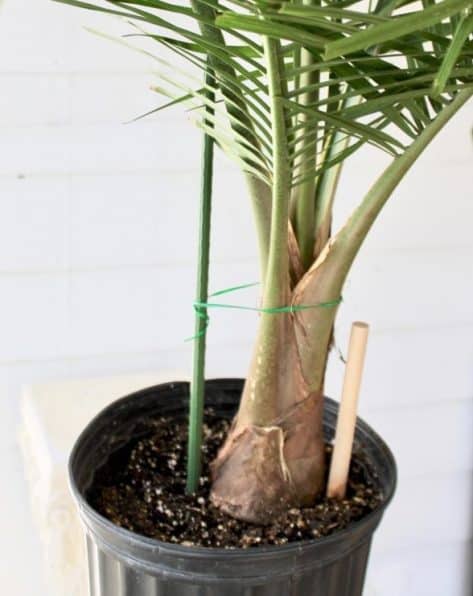
How much water does a Majesty Palm need?
If there is one thing you should remember about the water needs of a Majesty Palm, it is to never let the soil get completely dry. This plant is a tropical, moisture loving plant. But that does not mean you should soak it either. The majestic palm does not like to sit in water or it develops root rot.
As a general rule of thumb, water the Majesty Palm every day if it is sitting in the sun or planted outside in a hot, dry climate. If the top 2-3 inches of soil look and feel dry, it is time to give the palm a drink.
How much light does a Majesty Palm need?
Just like the water needs, there is a fine balance when considering how much light a majesty palm needs. While it prefers 4-8 hours a day of bright light, the light should be indirect so as not to scorch the leaves.
Prolonged exposure to the heat of direct sunlight is not recommended, both for the health of the leaves and to avoid drying the soil out too quickly. A bright, sunny window is the perfect spot when planted indoors.
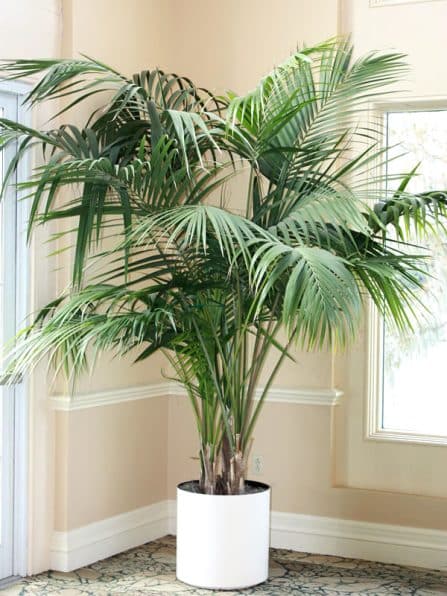
What are the temperature & humidity needs?
Like any tropical plant, the Majesty Palm prefers heat and high humidity. If grown outdoors, it will thrive best in hardiness zones 10-11 as anything lower will get too cold and too dry during the winter months.
Even when grown indoors it is best to keep the temperature around the plant at 65 to 85 degrees Fahrenheit, room temperature is about perfect.
Does this plant need fertilizer?
Like most plants, the Majesty Palm does enjoy some extra nutrients. However, they are not necessary to its overall growth. It is a relatively easy-going plant that only needs to be fertilized once or twice during the growing season of spring and summer and not at all during the winter.
The best option for fertilizing this tropical palm is a liquid fertilizer that is formulated for houseplants, and more specifically palms or cactus plants. There should an NPK balance that is high on potassium but low on phosphorous. To really add to the lushness of the fronds, look for a plant food that also contains magnesium, iron, and sulfur.
How to prune a Majesty Palm?
There is not a lot to do when it comes to pruning a Majesty Palm. Since it is a slow-growing palm that typically develops in a symmetrical, up-right pattern pruning it to a certain height or shape is not recommended. In fact, the only thing that should be pruned are any dead or yellowing leaves.
Can you propagate a Majesty Palm?
Yes, it is possible to propagate a Majesty Palm, however it is not always done as easily as many other houseplants. This slow-grower will eventually produce a fruit that can be harvested for its seeds, which can then be planted in soil to start a new plant. But this can be a long process and seeds are not always readily available.
Majesty Palm leaves cannot be cut to propagate either. So the best way to start a new plant is to wait until you see small offshoots, or pups, growing near the base of the mature plant. NOTE – do NOT just cut the pups out. You will need to divide them from the larger plant by taking it out of the pot, loosening the root ball, and separating the whole pup including its roots.

This small offshoot can then be planted in soil and kept watered and fertilized until its growth is sufficient.
Similar Majesty Palm Plant Varieties
When planning your indoor tropical paradise, there are several other relatives of the Majesty Palm to consider:
Kentia Palm – A close relative of the Majestic palm, the Kentia is an even easier tropical plant to grow indoors. It is often recommended for beginners to indoor gardening. Its fronds are more feather-like and it grows from a single stem that turns to brown as it matures.

Areca Palm – The Areca palm, or Chrysalidocarpus lutescens, also has a reputation for being easier to grow indoors than the Majesty palm. Its fronds have a more feathery appearance and it typically grows slower only reaching about 4-5 feet tall indoors.

Parlor Palm – If you don’t have a lot of window space or lower lighting conditions, you may want to consider the Parlor Palm. It is low maintenance and does not require the amount of light as most of its relatives. More resembling a shrub, this palm has deep green leaves that grows in clumps.
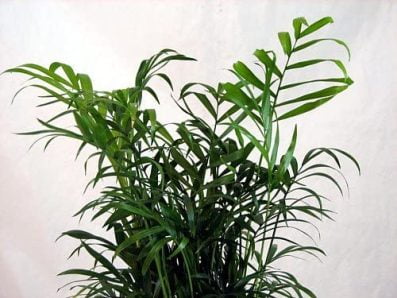
Common Majesty Palm Diseases and Pests
Diseases
Majesty Palm diseases are very rare and typically only appear in young plants. Common diseases include leaf blights and leaf spot that are caused by bacteria.

More common than diseases are simple problems like leaves turning yellow or brown. Brown leaves are typically scorched due to too much sunlight, simply move the plant to a less direct source of light. Yellow leaves can be a nutrient deficiency or simply a sign of over or under watering.
Pests
The most common pests on a Majesty Palm are small insects including spider mites and fungus gnats. Both of these are easily treated by misting the leaves with a mixture of soap and water a couple times a day until they disappear. If this doesn’t work, try a more aggressive treatment like an organic insecticide.
FAQ’s
Is Majesty Palm toxic to cats?
No, like all palms, the Majesty palm is not toxic to cats or any other pets.
Do Majesty Palms need sun?
Yes, the majesty palm needs bright, indirect sunlight for 6-8 hours per day in order to thrive.
Is a Majesty Palm an indoor or outdoor plant?
While it is more commonly used as an indoor plant, the Majesty Palm can be an outdoor plant when given the right growing conditions. It should only be grown outdoors in tropical locations within growing zones 10-11.
It is possible to move a potted Majesty Palm outdoors in areas that maintain a temperature of 55 degrees Fahrenheit or above during the spring and summer months. However, once temperatures dip below 55 and there is a chance of frost, it should be moved back indoors.
Why are the tips of my Majesty Palm turning brown?
There are several reasons the tips of the Majesty palm leaves are turning brown. The most common is that it is receiving too much hot sunlight and the leaves are scorched. This can be easily remedied by moving the plant to a location with less sunlight or where it can get variegated, indirect light.

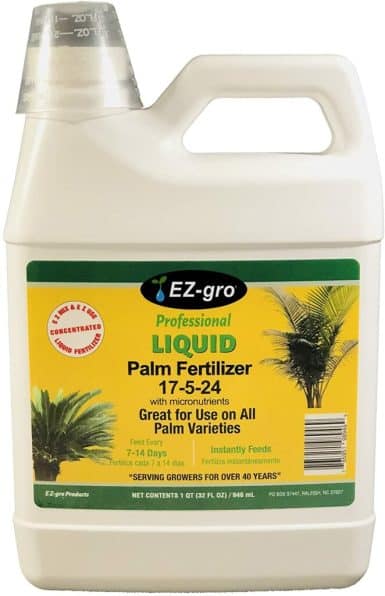
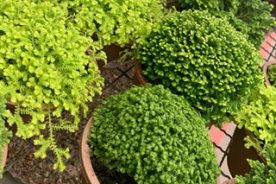
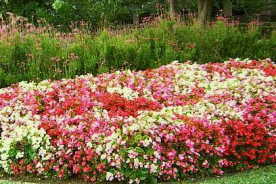


No Comments